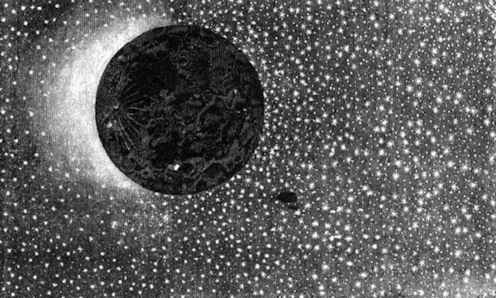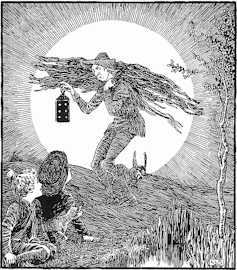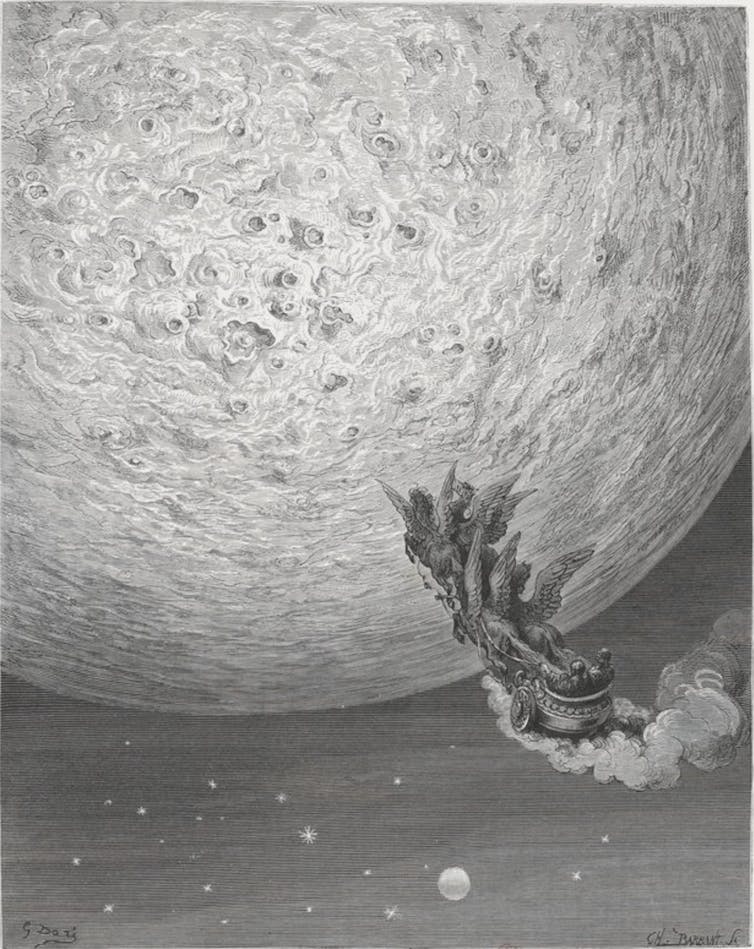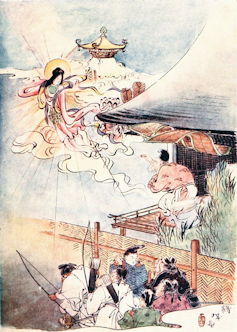
With the Japan mission to the Moon just beginning and with the space race to its south polar region, we are reminded of the wonder and excitement of travelling to the Moon.
Of course, since the 20th century, humans have been able to physically travel there, but imagining travel to the Moon has been part of our history from long before the 1900s. Looking back through the centuries reveals exciting stories of lunar adventure.
1. An English poem: The Man in the Moon

The English poem, The Man in the Moon, tells the story of a man who is living and suffering on the Moon. The poem is in a famous book known as the Harley manuscript, which was written in the 1300s.
There are many versions of this folktale, including in English, German and Dutch traditions. In this English version of the story, the man on the Moon (known as Hubert) is imagined as a medieval peasant guilty of stealing thorns to make a hedge. Medieval peasants would make hedges to act as fences, which were important for keeping animals from wandering.
It’s said in this poem that Hubert was born and raised on the Moon, though he also seems to be imprisoned there. In other traditions elsewhere in Europe, the peasant’s punishment is to be exiled to the Moon.
The person who speaks in the poem is on Earth, looking up at Hubert and trying to help free him from his imprisonment.
The cunning plan is this: the speaker and his wife will distract the “hayward” (legal official) by getting him drunk and then stealing the pledge (the penalty) the hayward has taken, in order to release Hubert. But unfortunately, Hubert can’t seem to hear the speaker of the poem and the speaker grows frustrated.
In this poem, there is a comical attempt to connect with Hubert – an attempt to bring the Moon and the Earth that bit closer.
2. An Italian epic poem: Orlando Furioso

Orlando Furioso (The Frenzy of Orlando) is an Italian epic written by poet Ludovico Ariosto (1474-1533). It tells the story of Charlemagne’s knights and their adventures. Charlemagne (who died in 814) was a king and emperor who is known for uniting most of Europe under his rule. Unsurprisingly, there are many legends about him and his knights.
One of his knights is Astolfo, cousin to the knight Orlando. Orlando has “lost his mind” or “lost his wits”. His lost sanity can only be found on the Moon and so Astolfo has to travel there.
When Astolfo is on the Moon, he discovers that it is a kind of dump site and all that has been lost from Earth has found its way there – which is why Orlando’s lost sanity can be found on the Moon.
The Moon carries not only physical objects but also abstract ideas like fame, broken promises and the tears and sighs of lovers. The one thing Astolfo can’t find on the Moon is foolishness – because there is plenty of that here on Earth.
In this poem, the Moon becomes a reflection of Earth and its people, with all their limitations and frailties.
3. A Japanese story: The Tale of the Bamboo Cutter

What about Moon people travelling to the Earth? This very thing happens in a Japanese story from the late 800s or early 900s: Taketori Monogatari (The Tale of the Bamboo Cutter).
An old man, while cutting bamboo, finds a tiny, three-inch girl bathed in light. He takes her home and he and his wife nurture her tenderly, even placing her in a cradle.
She grows up remarkably quickly under the care of her adoptive parents, bringing them great joy. They bring a diviner to grant her a name, and she is called Nayotake no Kaguya-hime (Shining Princess of the Young Bamboo).
But in her adult years, Kaguya-hime keeps looking at the Moon with great sadness and her loved ones are worried about her. She eventually reveals what is wrong – she is not an earthling.
She actually comes from the Moon and now she must return there. A magnificent troop comes to take her away and Kaguya-hime is forced to leave the people on Earth she has grown to love.
The Tale of the Bamboo Cutter is the earliest surviving example of the monogatari (tale, novel) and has been adapted into a Studio Ghibli animation, The Tale of Princess Kaguya.
The Moon has always been a place that inspires imaginative stories of travel, adventure, and discovery. The Tale of the Bamboo Cutter also reminds us that these stories are not found only in Europe.
All these texts – the English poem, the Italian epic, the Japanese narrative – raise important questions about what it is to be human, and how valuable the Earth is itself.

Looking for something good? Cut through the noise with a carefully curated selection of the latest releases, live events and exhibitions, straight to your inbox every fortnight, on Fridays. Sign up here.
Ayoush Lazikani does not work for, consult, own shares in or receive funding from any company or organization that would benefit from this article, and has disclosed no relevant affiliations beyond their academic appointment.
This article was originally published on The Conversation. Read the original article.







